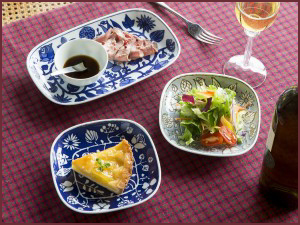http://omamorifromjapan.blogspot.jp/2011/08/nagasaki-folk-toys.html
..................................................................................................................................................................
Hasami 波佐見
Hasamiyaki, Hasami-yaki 波佐見焼 Hasami creamics
Hasami is located close to Arita and Imari, but not nearly as famous.
Its manufacturers historically focused on mass-market ceramic products for ordinary Japanese people.
. hahsioke Daruma 箸置け chopstick rest from Hasami .
- quote -
Hasami Porcelain
Tasteful and stylish, Hasami porcelain has been enjoying a resurgence in popularity in Japan. The craft can be traced back over 400 years to 1599, when three multi-chambered climbing kilns (called renboshiki-noborigama) were installed in the town of Hasami in central Nagasaki Prefecture. Marking the dawn of the area's ceramics industry, this was the origin of Hasami porcelain.

While Hasami originally produced glossed ceramics known as yuyaku-toki, the discovery of natural deposits of porcelain constituents led to a gradual shift in production. In time, the local focus centered around celadon porcelain (called seiji in Japan) and blue and white sometsuke porcelain.
Traditional Hasami porcelain focused on everyday necessities, with standout products including the kurawanka bowl and the konpura bottle. The kurawanka bowl was a thick, durable porcelain bowl with arabesque designs called kurawanka applied by brush. Through mass-production—still uncommon at the time—common people were able to buy these bowls at an affordable price, leading to nationwide popularity.
Meanwhile, the konpura bottle was a dyed white porcelain bottle used to store products such as soy sauce and saké for export to Europe—a necessity since Nagasaki was the only area permitted to engage in international trade during the Edo Period (1603-1868). It's even said the great Russian writer Leo Tolstoy had a konpura bottle on his study desk.
By developing products that met people's everyday needs, Hasami porcelain has long been valued both inside and outside of Japan. Characterized by elegantly shaped, nearly translucent white porcelain contrasted with gosu indigo pigment, its techniques are still passed on today, and will surely continue to be appreciated by people of all generations.
- source : japan-brand.jnto.go.jp/crafts -
kurawanka くらわんか is a local dialect, meaning " Why don't you eat something ?"
..................................................................................................................................................................
..................................................................................................................................................................
Hasami 波佐見
Hasamiyaki, Hasami-yaki 波佐見焼 Hasami creamics
Hasami is located close to Arita and Imari, but not nearly as famous.
Its manufacturers historically focused on mass-market ceramic products for ordinary Japanese people.
. hahsioke Daruma 箸置け chopstick rest from Hasami .
- quote -
Hasami Porcelain
Tasteful and stylish, Hasami porcelain has been enjoying a resurgence in popularity in Japan. The craft can be traced back over 400 years to 1599, when three multi-chambered climbing kilns (called renboshiki-noborigama) were installed in the town of Hasami in central Nagasaki Prefecture. Marking the dawn of the area's ceramics industry, this was the origin of Hasami porcelain.

While Hasami originally produced glossed ceramics known as yuyaku-toki, the discovery of natural deposits of porcelain constituents led to a gradual shift in production. In time, the local focus centered around celadon porcelain (called seiji in Japan) and blue and white sometsuke porcelain.
Traditional Hasami porcelain focused on everyday necessities, with standout products including the kurawanka bowl and the konpura bottle. The kurawanka bowl was a thick, durable porcelain bowl with arabesque designs called kurawanka applied by brush. Through mass-production—still uncommon at the time—common people were able to buy these bowls at an affordable price, leading to nationwide popularity.
Meanwhile, the konpura bottle was a dyed white porcelain bottle used to store products such as soy sauce and saké for export to Europe—a necessity since Nagasaki was the only area permitted to engage in international trade during the Edo Period (1603-1868). It's even said the great Russian writer Leo Tolstoy had a konpura bottle on his study desk.
By developing products that met people's everyday needs, Hasami porcelain has long been valued both inside and outside of Japan. Characterized by elegantly shaped, nearly translucent white porcelain contrasted with gosu indigo pigment, its techniques are still passed on today, and will surely continue to be appreciated by people of all generations.
- source : japan-brand.jnto.go.jp/crafts -
kurawanka くらわんか is a local dialect, meaning " Why don't you eat something ?"
..................................................................................................................................................................
No comments:
Post a Comment